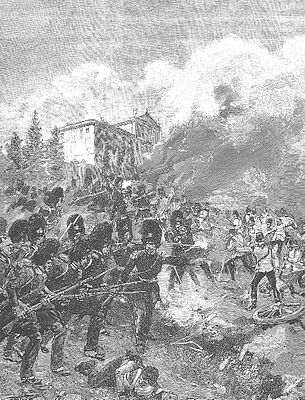Battle of Custoza (1848)
| First Battle of Custoza | |||||||
|---|---|---|---|---|---|---|---|
| Part of the First Italian War of Independence | |||||||
 |
|||||||
|
|||||||
| Belligerents | |||||||
|
|
|
||||||
| Commanders and leaders | |||||||
|
|
|
||||||
| Strength | |||||||
| 33,000 | 22,000 | ||||||
| Casualties and losses | |||||||
|
23–26 July: 289 KIA incl. 19 Officers 1,144 wounded 2,380 POW/MIA (26–27 July at Volta): 77 KIA incl. 2 Officers 175 wounded 202 POW/MIA |
23–26 July: 254 KIA 790 wounded 463 POW/MIA (26–27 July at Volta): 67 KIA 263 wounded 352 POW/MIA |
||||||
The First Battle of Custoza was fought on July 24 and 25, 1848 during the First Italian War of Independence between the armies of the Austrian Empire, commanded by Field Marshal Radetzky, and the Kingdom of Sardinia, led by King Charles Albert of Sardinia-Piedmont.
In March 1848, the city of Milan launched an uprising against Austrian occupation. Charles Albert supported the Milanese revolt and declared war on Austria. Venice also declared its independence from Austria. The Austrian Field Marshal Radetzky withdrew his forces from Milan to the defensive positions based on the four fortresses known as the Quadrilateral: Verona, Mantua, Peschiera, and Legnago. The Piedmontese took Peschiera after a short siege, but Radetzky received substantial reinforcements.
Around the 15th July, the Piedmontese Army was widely dispersed on the war theater, from the Rivoli plateau on the north to Governolo on the south. Marshal Radetzki attacked, on July 23, the Piedmontese II Corps (commanded by General Ettore Gerbaix De Sonnaz), and forced it to retire first before Peschiera and then, after another successful attack on the 24th, behind the river Mincio, separating the Piedmontese Army in two.
The Piedmontese High Command reacted slowly and uncertainly to the news coming from the north, and eventually it was decided to attack the Austrian army in the rear towards the village of Staffalo, with the bulk of the I Corps (led by General Eusebio Bava); the attack, begun in the afternoon of the 24th, was successful and the single brigade which covered this area was forced to retreat. However, this lulled the Sardinian commanders into a false sense of complacency, and spurred Radetzki to stop his advance beyond the Mincio and march on these enemy forces.
...
Wikipedia
